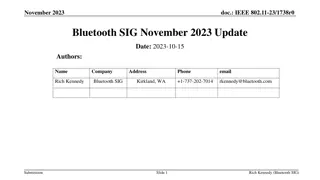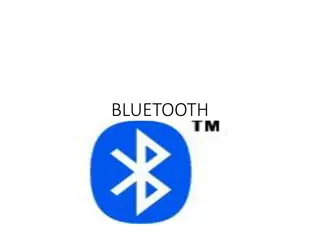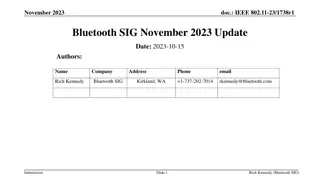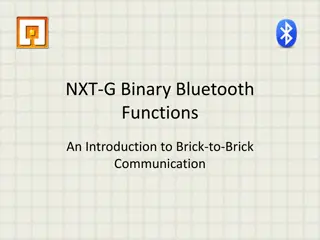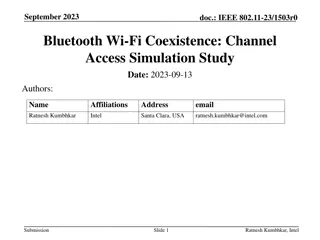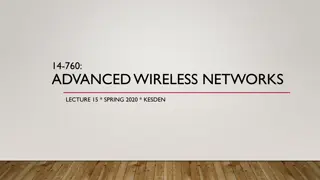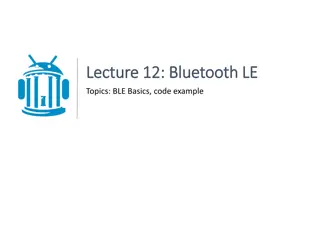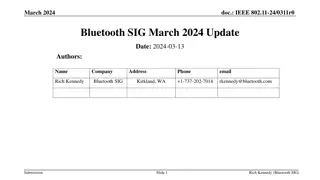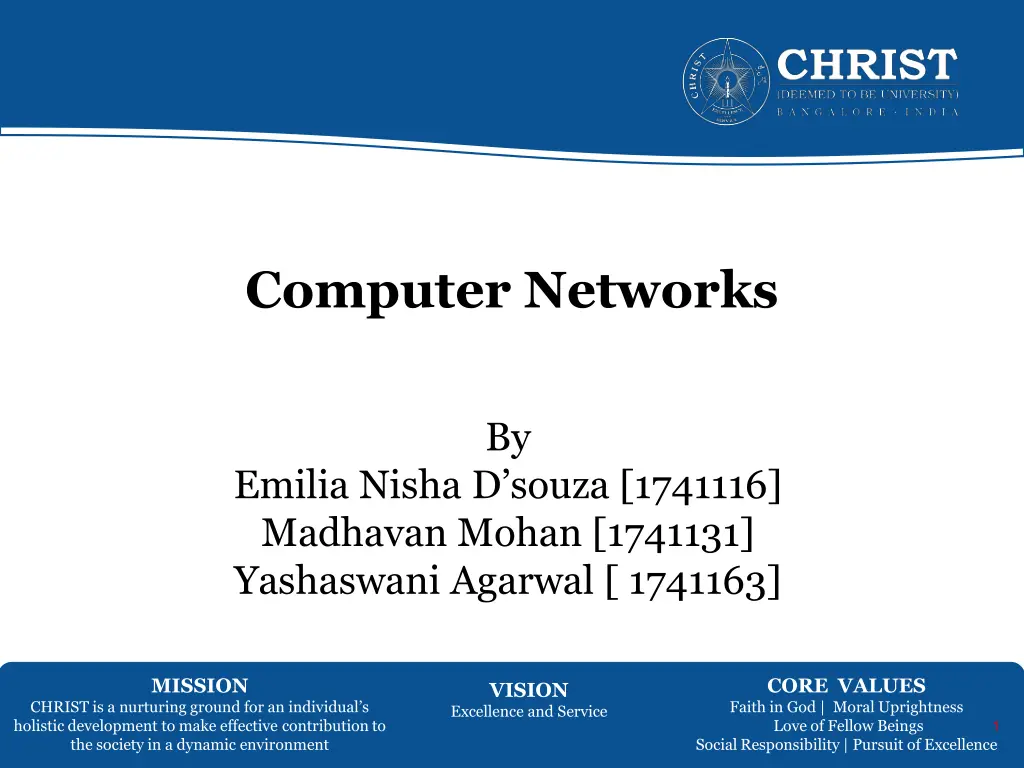
Bluetooth Profiles in Computer Networks
Explore the world of Bluetooth profiles in computer networks at CHRIST Deemed-to-be University. Learn about the different Bluetooth profiles, including Generic Access, Service Discovery, Serial Port, and more. Understand how these profiles facilitate wireless communication between devices and enhance connectivity in short-range wireless networks. Dive into the realm of excellence and service in Bluetooth technology.
Download Presentation

Please find below an Image/Link to download the presentation.
The content on the website is provided AS IS for your information and personal use only. It may not be sold, licensed, or shared on other websites without obtaining consent from the author. If you encounter any issues during the download, it is possible that the publisher has removed the file from their server.
You are allowed to download the files provided on this website for personal or commercial use, subject to the condition that they are used lawfully. All files are the property of their respective owners.
The content on the website is provided AS IS for your information and personal use only. It may not be sold, licensed, or shared on other websites without obtaining consent from the author.
E N D
Presentation Transcript
Computer Networks By Emilia Nisha D souza [1741116] Madhavan Mohan [1741131] Yashaswani Agarwal [ 1741163] MISSION CORE VALUES Faith in God | Moral Uprightness Love of Fellow Beings Social Responsibility | Pursuit of Excellence VISION Excellence and Service CHRIST is a nurturing ground for an individual s holistic development to make effective contribution to the society in a dynamic environment 1
CHRIST Deemed to be University 1. A standard for the short-range wireless interconnection of mobile phones, computers, and other electronic devices. 2. It is an ad hoc network 3. It can not be large. If there are many gadgets that try to connect, there is chaos 2 Excellence and Service
CHRIST Deemed to be University BLUETOOTH DEVICES 3 Excellence and Service
CHRIST Deemed to be University BLUETOOTH PROFILES A Bluetooth profile is a specification regarding an aspect of Bluetooth-based wireless communication between devices. The way a device uses Bluetooth technology depends on its profile capabilities. The profiles provide standards which manufacturers follow to allow devices to use Bluetooth in the intended manner. 1. Generic 2. Building Block 3. Networking 4. Telephony 5. Object Exchange 4 Excellence and Service
CHRIST Deemed to be University Generic 1. Generic Access This profile defines the generic procedures related to discovery of Bluetooth devices (idle mode procedures) and link management aspects of connecting to Bluetooth devices (connecting mode procedures). It also defines procedures related to use of different security levels. 2. Service Discovery This profile defines the features and procedures for an application in a Bluetooth device to discover services registered in other Bluetooth devices and retrieve any desired available information. 5 Excellence and Service
CHRIST Deemed to be University Building Block 1. Serial Port Essentially, the Serial Port Profile defines the protocols and procedures that shall be used by devices using Bluetooth for RS232 (or similar) serial cable emulation. The scenario covered by this profile deals with legacy applications using Bluetooth as a cable replacement, through a virtual serial port abstraction (which in itself is operating system-dependent). 2. Generic Object Exchange It defines a client server relationship for object movement and building block for other profiles 6 Excellence and Service
CHRIST Deemed to be University Networking 1. Lan Access Allows a Bluetooth device to connect to a fixed network 2. Dial up Networking It allows a notebook computer to connect to a mobile phone containing a built in modem without wires. 3. Fax It allows wireless fax machines to send and receives faxes. 7 Excellence and Service
CHRIST Deemed to be University Telephony 1. Cordless Telephony Profile - CTP allows a Bluetooth-enabled cell phone to be used as a cordless telephone when it is within range of a Bluetooth CTP access point. CTP is thus a way of adding limited mobility cordlessness to the fixed network. 2. Intercom Profile - As the intercom usage is completely symmetrical, there are no specific roles defined. A device supporting the Intercom profile will generally be denoted as Terminal . Example: Two (cellular) phone users engaged in a speech call, on a direct phone-to-phone connection using Bluetooth only. Allows two telephones to connect as walkie-talkies. 3. Headset Profile - The Headset Profile defines a simple audio connection between a Bluetooth audio gateway, like a cell phone, and a headset. Example while driving a car 8 Excellence and Service
CHRIST Deemed to be University Object Exchange 1. Object Push Provides a way to exchange simple objects. 2. File Transfer provides a more general file transfer facility 3. Synchronization Profile This profile defines the requirements for the protocols and procedures that shall be used by the applications providing the synchronization usage model 9 Excellence and Service
CHRIST Deemed to be University RADIO LEVEL The radio layer is roughly equivalent to the physical layer of the Internet model. Bluetooth devices are low-power and have a range of 10 m. Band Bluetooth uses a 2.4-GHz ISM band divided into 79 channels of 1 MHz each. FHSS Bluetooth uses the frequency-hopping spread spectrum (FHSS) method in the physical layer to avoid interference from other devices or other networks. Bluetooth hops 1600 times per second, which means that each device changes its modulation frequency 1600 times per second. A device uses a frequency for only 625 s (1/1600 s) before it hops to another frequency; the dwell time is 625 s. 10 Excellence and Service
CHRIST Deemed to be University Modulation To transform bits to a signal, Bluetooth uses a sophisticated version of FSK, called GFSK (FSK with Gaussian bandwidth filtering; a discussion of this topic is beyond the scope of this book). GFSK has a carrier frequency. Bit 1 is represented by a frequency deviation above the carrier; bit 0 is represented by a frequency deviation below the carrier. The frequencies, in megahertz, are defined according to the following formula for each channel. Fc = 2402 + n MHz n =0, 1, 2, 3, . . ., 78 For example, the first channel uses carrier frequency 2402 MHz (2.402 GHz), and the second channel uses carrier frequency 2403 MHz (2.403 GHz). 11 Excellence and Service
CHRIST Deemed to be University IMPORTANT QUESTION Q. Explain in brief about Bluetooth architecture and give examples of some Bluetooth devices. 12 Excellence and Service
CHRIST Deemed to be University Thank You 13 Excellence and Service




